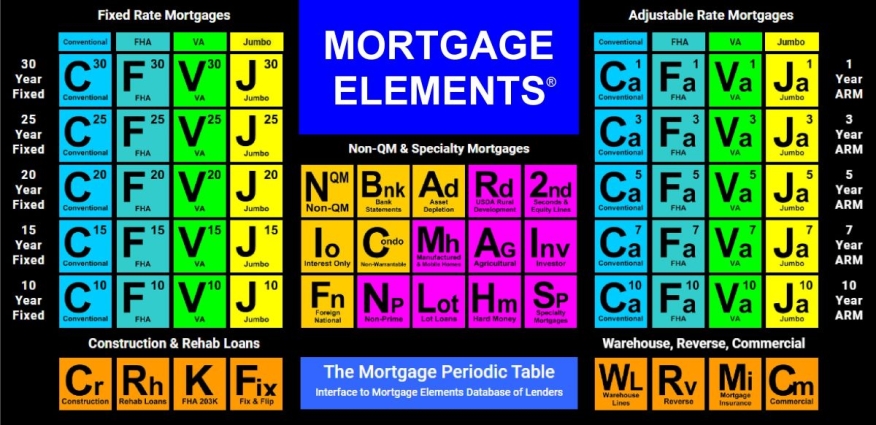Mortgage Economic Review for April 2024

The Mortgage Economic Review is a monthly summary of Key Economic Indicators, Data, and Events pertinent to Mortgage, Housing, and Finance Professionals.
At A Glance - Key Economic Events and Data released during March 2024
- Interest Rates: The 10-year Treasury yield fell to 4.20% (Mar 28) from 4.25% (Feb 29).
- Housing: February Existing Home Sales rose 9.5% (-3.3 YoY), New Home Sales fell 0.3% (+5.9% YoY), and Home Prices fell 0.1% (+6.3% YoY).
- Labor: The US Economy created 275,000 New Jobs in February. The Unemployment Rate rose to 3.9%. Wage Growth rose at a 4.3% YoY pace.
- Inflation: CPI rose 0.4% in February (+3.2% YoY), and PCE rose 0.3% (+2.8% YoY).
- The Economy: US GDP grew by a 3.4% annualized rate in 4Q2023, up 3.1% YoY.
- Consumers: Retail Sales rose 0.6% in February (+1.5% YoY), Consumer Confidence fell while Sentiment rose.
Interest Rates and Fed Watch
The Fed wrapped up the FOMC Meeting on March 20th and left Interest Rates unchanged. The target range for Fed Funds will remain at 5.25% - 5.50%, where it has been since July 26, 2023. The Fed also reiterated its resolve to fight Inflation and the intention to do three Rate Cuts in 2024. When will the Fed make the first Rate Cut? No one knows - not even the Fed. The Fed is Data Dependent, so they will wait until the Data tells them it's time to cut Interest Rates. Don't expect the Fed to drop rates until we get at least 2 consecutive months of lower Inflation Data. If that doesn't happen, there may be no Rate Cuts in 2024.
- 10-Year Treasury Note Yield fell to 4.20% (Mar 28) from 4.25% (Feb 29).
- 30-Year Treasury Bond Yield fell to 4.34% (Mar 28) from 4.38% (Feb 29).
- 30-Year Fixed Mortgage fell to 6.79% (Mar 28) from 6.94% (Feb 29).
- 15-Year Fixed Mortgage fell to 6.11 (Mar 28) from 6.26% (Feb 29).
Housing Market Data Released in March 2024
The latest Housing Data shows a divergence between New Home Prices and Existing Home Prices. While Existing Home Prices continue to rise, New Home Prices are falling. New Home Data is notoriously volatile, and there is a lot of noise in the data, but the trend is lower. Supply chain issues are mostly resolved and Skilled Labor is more plentiful. Builders are designing and constructing more affordable homes. All these factors contribute to the improvement in New Home affordability. The New Home Market is setting up to be a bright spot in Real Estate in 2024.
- Existing Home Sales (closed deals in February) rose 9.5% to an annual rate of 4,380,000 homes (3,970,000 SFR, 410,000 Condos), down 3.3% in the last 12 months. The median Single-Family Home price is $388,700, up 5.6% YoY. The Median Condo price is $344,000, up 6.7% YoY. Homes were on the market for an average of 38 days. Currently, 1,070,000 homes are for sale, up 10.3% YoY.
- New Home Sales (signed contracts in February) fell 0.3% to a seasonally adjusted annual rate of 662,000 homes, up 5.9% YoY. (668,000 New Homes were sold in 2023). The median New Home price is $400,500 (Peak of $496,800 in Oct 2022). The average price is $485,000 (Peak of $568,700 in Dec 2022). There are 463,000 New Homes for sale, (Low of 281,000 in October 2020), an 8.4-month supply.
- Pending Home Sales Index (signed contracts in February) rose 1.6% to 75.6 from 74.3 the previous month, down 7.0% YoY.
- Building Permits (issued in February) rose 1.9% to a seasonally adjusted annual rate of 1,518,000 units - up 2.4% YoY. Single-family permits rose 1.0% to an annual pace of 1,031,000 homes, up 29.5% YoY.
- Housing Starts (excavation began in February) rose 10.7% to an annual adjusted rate of 1,521,000, up 5.9% YoY. Single-family starts rose 11.6% to 1,129,000 units, up 35.2% YoY.
- Housing Completions (completed in February) rose 19.7% to an annual adjusted rate of 1,729,000 units - up 9.6% YoY. Single-family completions rose 20.2% to an annual adjusted rate of 1,072,000 homes - up 4.2% YoY.
- S&P/Case-Shiller 20 City Home Price Index fell 0.1% in January, up 6.6% YoY.
- FHFA Home Price Index fell 0.1% in January, up 6.3 % YoY.
Labor Market Economic Data Released during March 2024
The Economy created 275,000 New Jobs during February, surpassing Economists' expectations of 200,000. Of the 275,0000 New Jobs, 67K (24%) were in Health Care, 52K, (19%) in Government, 42K (15%) in Hospitality, 24K (9%) in Social Assistance, 23K (8%) in Construction, 20K (7%) in Transport & Warehouse, 19K in Retail (7%). This is a stellar Jobs Report, but a deeper dive into the data shows that small cracks are beginning to form in the Labor Market. Unemployment crept up to 3.9%, just shy of the 4.0% threshold. The Jobs Report also showed an increase in Part-time Jobs and a decrease in Temp Jobs, which are early hints that the Labor Market is beginning to cool.
- The Economy created 275,000 New Jobs during February.
- The Unemployment Rate rose to 3.9% from 3.7% in January, December, and November.
- The Labor Force Participation Rate remained at 62.5% in February, January and December.
- The Average Hourly Wage rose 0.1% during February, up 4.3% YoY.
- Job Openings fell to 8,863,000 during January from 9,026,000 in December.
Inflation Economic Data Released during March 2024
Most Economists were surprised and disappointed (again) by the February Inflation Data. All the major indicators - CPI, PCE, PPI - came in higher than expected. While the Inflation trend is still on a downward trajectory, the last 3 months of data showed a slight re-acceleration. The Fed has raised Interest Rates and tightened Monetary Policy to fight Inflation. Those tactics work with a lag, which takes time to percolate through the Economy. Unfortunately, that lag can be longer than we like. Expect Inflation to be higher for longer. Energy and Shelter costs continue to be the main drivers behind the rise in Inflation Data - Gasoline prices were up 3.8%, while Shelter Costs rose 0.4%.
- CPI rose 0.4%, up 3.2% YoY | Core CPI rose 0.4%, up 3.8% YoY
- PPI rose 0.6%, up 1.6% YoY | Core PPI rose 0.4%, up 2.8% YoY
- PCE rose 0.3%, up 2.5% YoY | Core PCE rose 0.3%, up 2.8% YoY
GDP Economic Data Released in March 2024
The 3rd and final revision for the 4th Quarter 2023 GDP showed the US Economy grew at a 3.4% annualized rate. For all of 2023, US GDP grew at a 3.1% annual rate. That is a significant number considering the challenges facing the Economy - higher Interest Rates, Restrictive Monetary Policy, two full-scale wars, and other Geopolitical issues. The Recession that Economists were talking about has yet to materialize. For reference, GDP growth in previous years was: 2019 +2.3%, 2020 -2.8%, 2021 +5.9%, 2022 +2.1%.
Consumer Economic Data Released during March 2024
Consumer Confidence held steady during February, along with a modest rise in Retail Sales. Generally speaking, Consumers feel good about job security and the Economy despite all the domestic and international issues. Their biggest concern is Inflation because they can see how it impacts their lives every time they go to the store.
- Retail Sales rose 0.6% during February, up 1.5% in the last 12 months.
- Consumer Confidence Index fell 0.1% to 104.7 from a revised 104.8 the prior month, up 0.7% YoY.
- Consumer Sentiment Index (U of M) rose to 3.2% to 79.4 from 76.9 the previous month.




